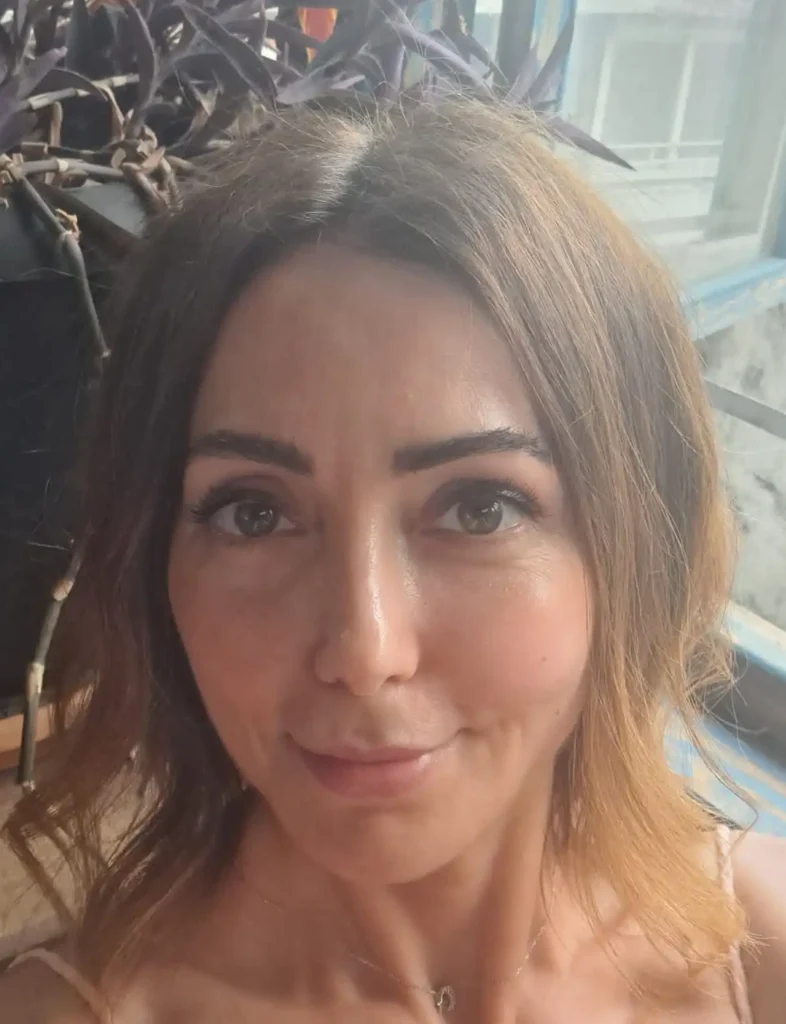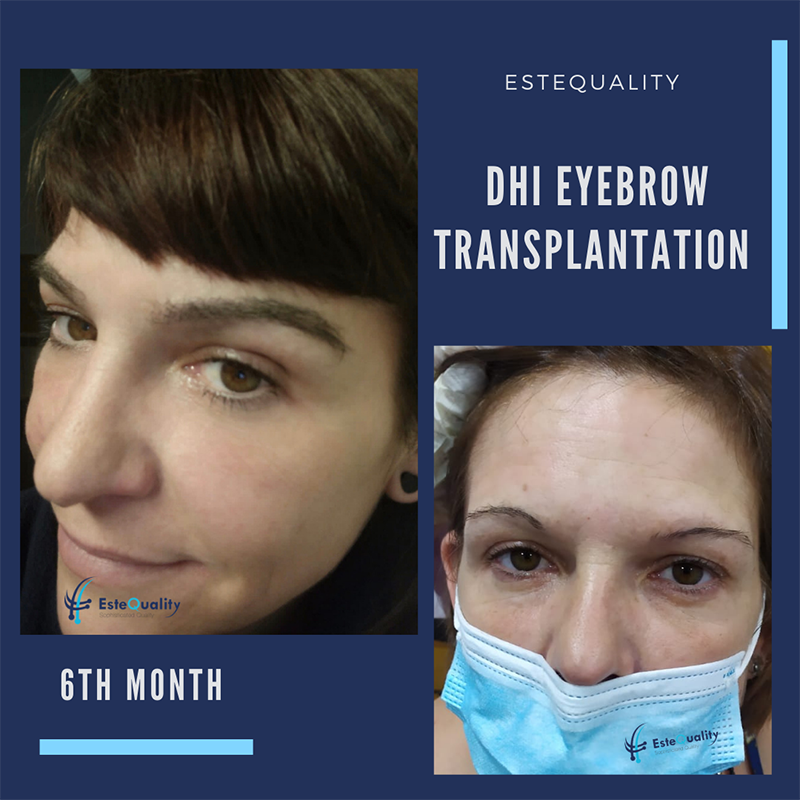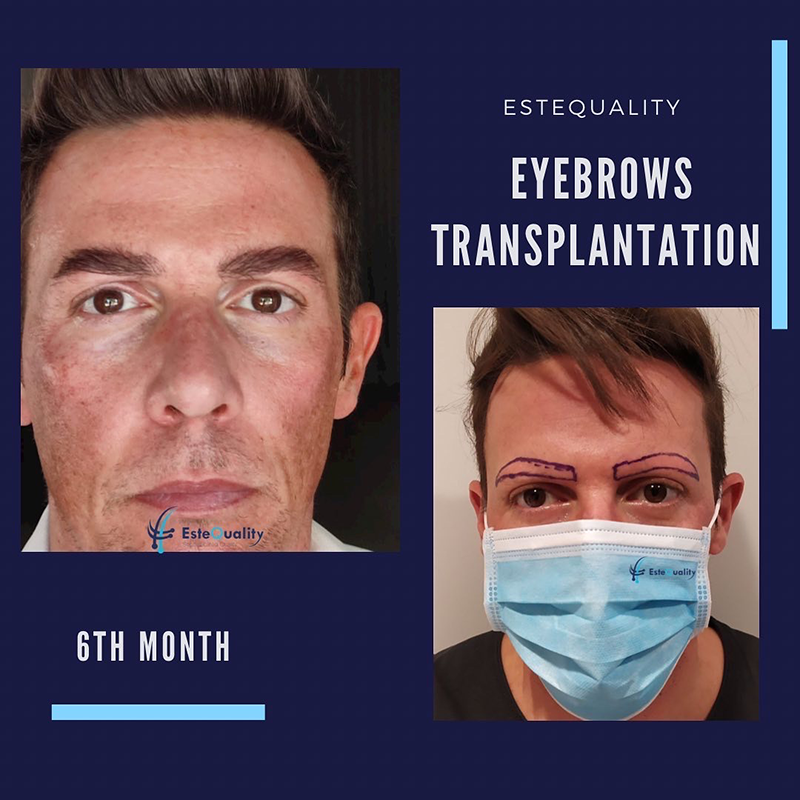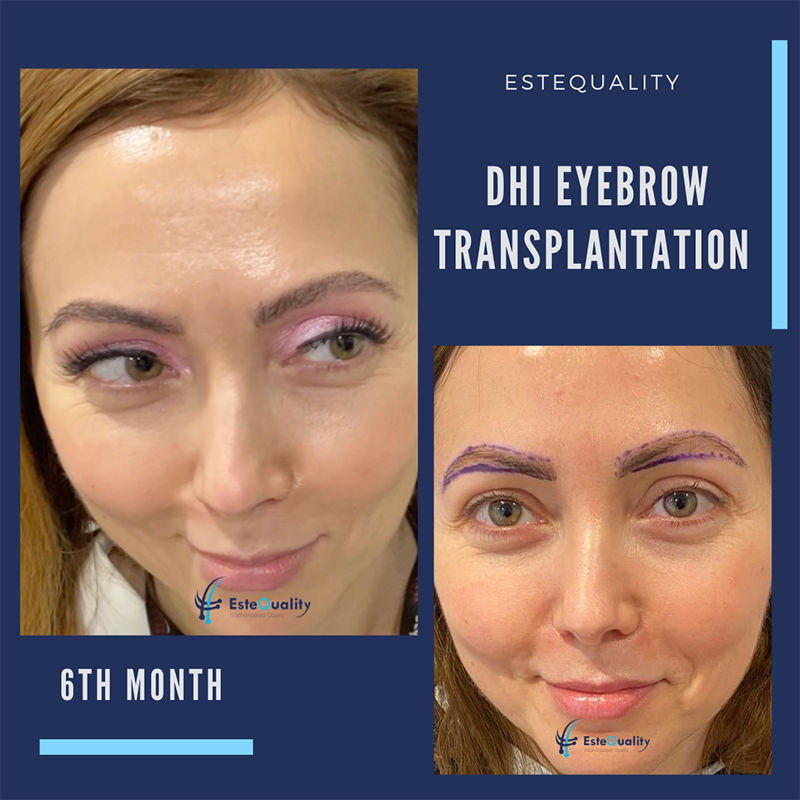When it comes to eyebrow transplantation, women are often the first to come to mind, as eyebrow loss is more common in women. The most frequent cause of eyebrow loss in women is over-plucking. Constantly plucking eyebrows from the root can lead to follicle damage, causing other hair follicles in the area to stop growing over time.
Other causes of eyebrow loss include hormonal imbalances or changes, diet, vitamin deficiencies, stress, menopause, pregnancy, or conditions like eczema.
Women often define their eyebrow shape using eyebrow tattoos (such as microblading, micropigmentation, or the hair stroke technique). However, since tattoos tend to fade and lack a natural appearance, many opt for eyebrow transplantation, which offers a more natural and permanent solution.
For men, eyebrow transplantation has also become more common, primarily for addressing genetic hair loss, image changes, or to repair damage caused by accidents.
What is Eyebrow transplantation?
Eyebrow transplantation is the process of transferring hair follicles from a small, hair-covered area at the back of the head to the eyebrow area. In other words, it is a tissue transplant.
The hair follicles (grafts) taken from the back of the head are strong and resistant to shedding for a lifetime. Only the area where the grafts are taken is shaved, so it’s not noticeable that a procedure has been performed. If the hair is longer than 3 cm, even the shaved area is not visible. The single and double hair follicles collected from the shaved area are transplanted to the eyebrow region using the DHI (Direct Hair Implantation) technique.
Eyebrow transplantation can be performed using both the FUE and DHI techniques, with DHI being the most commonly used method. In this technique, grafts are placed one by one into a tool called a CHOI pen and then transplanted into the eyebrow area.
With the latest technology, long hair eyebrow transplantation allows for immediate visibility of the direction and density of the newly transplanted eyebrows right after the operation. Any swelling that occurs typically subsides within three days, and complete recovery happens within ten days. Within the first month after the operation, some or all of the transplanted hairs may shed, depending on the individual. The shed hairs start to regrow after 2-3 months, and the desired appearance of the eyebrows is achieved in approximately seven months.
During the first year, the transplanted eyebrow hairs will grow like scalp hair. Afterward, they will begin to grow in line with natural eyebrow hair.
At EsteQuality, our medical consultants stay in touch with you before and after the procedure, tracking the recovery process through photos. This follow-up continues until the eyebrows have fully grown in.
If you’re looking for a natural and permanent solution for eyebrow transplantation, you can contact our medical consultants for free detailed information.
Eyebrow transplantation Surgery
Before the eyebrow transplant procedure begins, the doctor and patient determine the area where the new eyebrows will be implanted. Tests are then conducted to check for any infectious diseases. About 30 minutes later, the procedure begins.
The eyebrow transplant procedure typically lasts around 2 hours. First, the donor area at the back of the head, where the hair follicles will be taken from, is numbed using Dermojet (Needle-Free Anesthesia). The grafts (hair follicles) are then extracted one by one. Afterward, the recipient area (eyebrows) is numbed with a needle-based anesthesia. Using the DHI (Direct Hair Implantation) technique and a tool called the Choi Pen, the grafts are implanted into the eyebrow area.
The most crucial aspect of the eyebrow transplant is ensuring the grafts are implanted at the correct angles to achieve a natural appearance. The degree of naturalness in the results is directly related to the angles of implantation.
After the procedure, a small dressing is applied to the donor area at the back of the head. The dressing can be removed at home the next day, and the area typically heals within a few days. For the eyebrow area, any swelling subsides within 2-3 days, and within 7-10 days, scabs form and then fall off, completing the healing process. During this time, the patient must follow the doctor’s instructions for applying creams, shampoos, and cleaning the eyebrows (all necessary products and medications are provided post-operation).
During the healing phase, it’s important to avoid rubbing the eyebrows until the scabs have completely fallen off. A neck pillow is provided for the first 10 days after the procedure to prevent the eyebrows from rubbing against anything during sleep.
Depending on the individual’s physiology, some of the transplanted grafts may be lost. For example, some patients experience a loss of about 20% of the transplanted eyebrows, while others may lose all the transplanted hairs. However, starting from the third month post-surgery, the lost hairs will begin to regrow. Full recovery and eyebrow growth take about 6-10 months, depending on the individual’s physiological structure.
Eyebrow transplantation reviews
Those who undergo eyebrow transplants are typically very satisfied with the results. The primary reason for this satisfaction is the positive feedback they receive from people around them. Compared to other cosmetic procedures, eyebrow transplantation offers the most natural and permanent solution.
Within a maximum of 15 days after the eyebrow transplant, it is usually no longer noticeable that the procedure was performed. This period can vary from person to person, as the healing process depends on age and individual physiology. For some, full recovery can occur in as little as 5 days.
People who opt for eyebrow transplants are often individuals who have grown tired of microblading, also known as eyebrow tattoos. In short, eyebrow transplantation is the preferred choice for those seeking a natural-looking solution.

Derya was extremely pleased with the eyebrow transplant procedure and is delighted to have chosen EsteQuality. Our medical consultants were by her side both before and after the surgery, providing support whenever needed. This ensured that her questions were answered promptly. She expressed that her appearance has completely transformed, and when asked whether to choose eyebrow tattoos or an eyebrow transplant, Derya confidently recommends eyebrow transplantation.
Before and After Eyebrow Transplantation
Before eyebrow Transplant
- Consultation: Before the procedure, a detailed consultation is conducted to analyze the eyebrow area and determine the desired shape and thickness.
- Anesthesia: The donor area (usually the back of the head) is numbed using Dermojet (needle-free anesthesia), and grafts are extracted one by one.
- Shaving (if required): If the donor area needs to be shaved, it’s done in a small area that remains hidden under longer hair.
- Preparation: The eyebrow area is also numbed to ensure a painless experience during the transplant.

After Eyebrow Transplantation
- Healing Process: Swelling may appear within the first 2-3 days but subsides quickly. Scabs will form and fall off within 7-10 days.
- Post-Operative Care: Special creams and shampoos are provided to aid healing, and it’s important to avoid rubbing the area during recovery.
- Shedding and Regrowth: Some of the transplanted hairs may shed within the first month, but regrowth typically starts around 2-3 months after the procedure.
- Final Results: Full eyebrow growth takes about 6-10 months, and the final shape and density become apparent at this time.
Patients who undergo eyebrow transplants typically experience natural and long-lasting results.
When looking at before and after photos of eyebrow transplants, the incredible difference is clear to everyone. Eyebrows drawn with a pencil are noticeable to others, while the results of an eyebrow transplant are virtually undetectable.

Post-operative care
After the operation, you should be careful not to rub the eyebrows anywhere until the scabs fall off. You sleep with the neck pillow provided by us.
You should not scratch the eyebrow area during the scabbing process.
One day after the operation, the eyebrows are washed and moistened with the shampoo given to us. This process is repeated daily until the scabs fall off.
There is no harm in taking a shower after the operation, and it will be enough not to touch your eyebrows with pressurized water in the shower. Those planted with pressurized water may cause the grafts to come out.
Our medical consultants want you for a photo every two to three days after the operation to control it. After the scabs fall out, we check them once a month until a year is completed.
After the scabs fall off, you patiently wait for your new eyebrows to grow without having to do anything.
When your new eyebrows start to grow, they are combed daily with an eyebrow brush, thus correcting their direction.
At first, they grow faster than normal eyebrows, and that’s why you cut regularly. Afterward, they rise to the same extent, similar to other eyebrows.
Eyebrow Transplant Cost in Turkey in 2025
Eyebrow transplant cost in Turkey in 2025 vary depending on the country and city.
- In the United States, the cost of an eyebrow transplant ranges between $3,000 and $8,000.
- In Europe, prices range between €3,000 and €5,000.
- In Turkey, however, the price is much more affordable.
In Istanbul, Turkey, international patients are often offered package deals that include transportation and accommodation services. For local patients, the average cost of an eyebrow transplant in 2025 is around $1,500. This is an average price, and due to the free-market economy, prices may vary between doctors and clinics.
To find out if you are a suitable candidate for eyebrow transplantation, you can call us or send your photos to our medical consultants via WhatsApp. Our consultants will have your photos reviewed by our doctors and will respond shortly, answering all your questions about the procedure.
Additionally, if you are considering coming from another city or from abroad, you can check our packages page for more information.

Operation Time
2 Hours

Anesthesia
Local Anesthesia
Needle-Free Anesthesia

Sensitivity process
3 Days

Return to work
3 Days

Healing process
12 Days

Hospitalization
None
FREQUENTLY ASKED QUESTIONS
How many types of anesthesia techniques for eyebrow transplantation are there?
There are 2 types of anesthesia techniques. Local anesthesia and Needle-Free Anesthesia.
Local anesthesia is injected with standard needles, and anesthesia is performed on average in five minutes. Afterward, the injected area becomes completely numb. Thus, you will not have pain during and after the operation.
Pain Duration: Average of 5 minutes
Needle-Free Anesthesia is a device that gives anesthesia for the area of the operation by pressure, not by needles. After the site is entirely anesthetized, anesthesia is continued with a needle, and the person does not feel it.
We use this device only in the area where we take the grafts (donor area). Because some bruising occurs after the pressure in the using area, we do not use it in the transplant area.
Needle-free anesthesia is an ideal solution for people with needle phobia.
Pain Duration: Average of 3 minutes
What are the advantages of eyebrow transplantation?
There are several advantages to eyebrow transplantation, including:
- Natural-looking results: Eyebrow transplantation can create a natural-looking, fuller eyebrow that blends in seamlessly with your natural hair.
- Long-lasting results: The transplanted hair is permanent, so the results of the procedure can last for a year.
- Minimal scarring: With the DHI technique, the procedure is performed using a tool called CHOI pen which allows the surgeon to directly implant the hair follicles into the recipient area without making any incisions, resulting in minimal scarring.
- Safe and reliable: Eyebrow transplantation is a safe and reliable procedure when performed by a qualified, experienced surgeon.
- Increased confidence: A fuller, more attractive eyebrow can help to boost self-confidence and self-esteem.
- The procedure is performed under local anesthesia, which eliminates the risks associated with general anesthesia and the recovery period is faster.
- The procedure is minimally invasive, which means there is less pain and swelling compared to other hair transplantation techniques.
- It can correct the asymmetry of eyebrows and can also reshape the eyebrow by adjusting the height and angle of the tail of the eyebrow.
It’s important to note that every individual’s case is unique, so the results and recovery process may vary. It’s always best to consult with us from WhatsApp for personalized advice.
Why is Eyebrow transplantation in Turkey popular?
Turkey is a popular destination for many people looking to undergo eyebrow transplantation. The country has a reputation for providing high-quality medical care at a fraction of the cost of other countries. Additionally, Turkey is home to some of the world’s leading hair transplant surgeons and clinics, who are known for their expertise and experience in the field of eyebrow transplantation.
The procedure of eyebrow transplantation in Turkey is performed using the latest techniques and equipment to ensure the best results. One of the most popular method is DHI (Direct Hair Implantation) which is a modern and advanced method of hair transplantation. This method uses a tool called CHOI pen which allows the surgeon to directly implant the hair follicles into the recipient area without making any incisions, resulting in minimal pain, no scarring and a faster recovery.
The recovery process after the eyebrow transplantation in Turkey is relatively short, taking only 7-10 days. During this time, the transplanted hair will fall out, but this is normal and should not cause any concern. After a month, new hair will begin to grow, and after three months the hair will be fully grown and will look natural and permanent.
The experienced surgeons in Turkey use the latest techniques and equipment to ensure the best results, and the team of experts will be there with you every step of the way, from the initial consultation to the final follow-up, to make sure that you are completely satisfied with the results of your eyebrow transplantation.
Many people choose Turkey for their eyebrow transplantation because of the cost-effectiveness and the high-quality medical care that the country provides. Additionally, Turkey offers a great opportunity to combine the surgery with a vacation in a beautiful country.
Overall, eyebrow transplantation in Turkey is a safe and effective way to improve the appearance of your eyebrows. With the DHI technique and the expertise of the Turkish surgeons, the results will be natural, permanent, and you can enjoy your new look in a short period of time.
To whom is an eyebrow transplantation performed?
Eyebrow transplantation is typically performed for individuals who have sparse or patchy eyebrows due to genetics, over-plucking, or medical conditions such as alopecia. This procedure can also be performed for people who have experienced hair loss from chemotherapy, burns, or other types of injury.
The procedure can be performed on both men and women, and it can be used to create a fuller, more defined eyebrow shape, or to correct uneven or asymmetrical eyebrows. It’s also suitable for people who are looking to reshape their eyebrows by adjusting the height and angle of the tail of the eyebrow.
It’s important to note that before deciding to undergo an eyebrow transplant, it’s essential to have a consultation with a qualified hair transplant surgeon. We will evaluate your individual case and will recommend the best course of action, whether it’s eyebrow transplant or another solution that might suit your needs better.
Does eyebrow transplant hurt?
An eyebrow transplant procedure typically involves the use of needle-free anesthesia in the donor area, and a traditional needle-based anesthesia in the eyebrow area. This is because the needle-free method can cause facial bruising in the eyebrow region, so a needle-based method is typically used to minimize the risk of bruising. However since the area is small, it is not a very painful procedure.
What can I expect during an eyebrow transplant surgery?
During an eyebrow transplant procedure, you can expect the following:
- First, the eyebrow line is determined.
- The donor area is shaved.
- Then, the anesthesia technician anesthetizes the donor area with needle-free anesthesia, and then local anesthesia is performed with a needle.
- The surgeon will harvest hair follicles from the donor area, which is typically the back of your scalp.
- The surgeon will numb the area around your eyebrows using a local anesthesia injection.
- Next, the surgeon will carefully place the transplanted hair follicles into the incisions in your eyebrows with DHI technique.
- The procedure typically takes between 2-3 hours depending on the number of grafts and the technique used.
- After the surgery, the surgeon will apply bandages to the donor area, and you will be provided with instructions for care and recovery.
- The day after the operation, the surgeon call you back to the hospital to remove the bandage, to check and for the washing process.
- You may experience some swelling, redness, and itching after the surgery, but these symptoms should subside within a few days.
- You can expect the transplanted hair to start falling out in 2-3 weeks, but don’t worry, this is normal. You can expect to see new hair growth within the next 3-4 months.
It’s important to note that the results and recovery vary from person to person, so it’s best to consult with us for more specific information on what you can expect.
What can I expect after an eyebrow transplant surgery?
After an eyebrow transplant procedure, you can expect the following:
- Recovery time: You may experience some swelling, redness, and itching after the surgery, but these symptoms should subside within a few days. You can expect the transplanted hair to start falling out in 2-3 weeks, but don’t worry, this is normal. You can expect to see new hair growth within the next 3-4 months.
- Care and Aftercare: Your surgeon will likely provide you with instructions on how to care for the transplanted area, which may include avoiding certain activities, such as heavy exercise, and avoiding harsh chemicals or hair treatments. You may need to apply antibiotic ointment or take medication to prevent infection. You will also be instructed to avoid sun exposure and not to scratch or rub the transplanted area.
- Appearance: The transplanted hair will look similar to your natural eyebrows, but initially, it will be shorter and less dense. The new hair will grow in over time and will eventually match the color and texture of your natural eyebrows.
The results of an eyebrow transplant can be very natural-looking and can help to define, shape and thicken the brows. However, you should keep in mind that results will vary depending on the individual, and it can take several months to see the final results.
After the operation, you should be careful not to rub the eyebrows anywhere until the scabs fall off. You sleep with the neck pillow provided by us.
You should not scratch the eyebrow area during the scabbing process.
One day after the operation, the eyebrows are washed and moistened with the shampoo given to us. This process is repeated daily until the scabs fall off.
There is no harm in taking a shower after the operation, and it will be enough not to touch your eyebrows with pressurized water in the shower. Those planted with pressurized water may cause the grafts to come out.
Our medical consultants want you for a photo every two to three days after the operation to control it. After the scabs fall out, we check them once a month until a year is completed.
After the scabs fall off, you patiently wait for your new eyebrows to grow without having to do anything.
When your new eyebrows start to grow, they are combed daily with an eyebrow brush, thus correcting their direction.
At first, they grow faster than normal eyebrows, and that’s why you cut regularly. Afterward, they rise to the same extent, similar to other eyebrows.
How much does an eyebrow transplant surgery cost in Turkey?
The cost of an eyebrow transplant surgery in Turkey can vary depending on several factors, including the type of procedure, the number of grafts needed, and the surgeon’s experience and qualifications. In general, the cost of an eyebrow transplant in Turkey can range from $800 to $2000. However, it’s important to keep in mind that these prices are subject to change, so it’s best to consult with us directly for the most accurate and up-to-date pricing information.
Eyebrow transplant or microblading?
Eyebrow transplants and microblading are two popular options for those looking to enhance the appearance of their eyebrows.
Eyebrow transplants, also known as eyebrow restoration, is a surgical procedure that involves transplanting hair from a donor area, such as the scalp, to the eyebrow area. The procedure is performed by a trained and qualified surgeon and typically takes between 2-3 hours. The transplanted hair will grow in over time and will eventually match the color and texture of the individual’s natural eyebrows.
The recovery period for an eyebrow transplant is typically 1-2 weeks, during which time the individual experience some swelling, redness, and itching. The results of an eyebrow transplant is very natural-looking and help to define, shape, and thicken the brows.
Microblading, on the other hand, is a semi-permanent makeup procedure that involves using a fine needle to deposit pigment into the skin. The procedure is performed by a trained and qualified microblading artist and typically takes between 1-2 hours. The results of microblading can last for up to 1-3 years, depending on the individual’s skin type and aftercare.
The recovery period for microblading is minimal, and the individual may experience some redness, and slight swelling, but overall the procedure is considered to be painless. Microblading can help to define, shape, and thicken the brows. However, it’s important to keep in mind that results will vary depending on the individual and touch-ups may be required.
Both eyebrow transplants and microblading are effective ways to enhance the appearance of the eyebrows. However, the choice between the two depends on the individual’s desired results, budget and lifestyle. Eyebrow transplants are a more permanent solution, but they require a surgical procedure and a recovery period, while microblading is a semi-permanent solution, it is less invasive, but touch-ups are required.
In conclusion, eyebrow transplant operation provides a better quality and natural solution than microblading.











